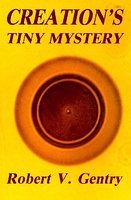| ESA | Return to https://www.halos.com/book/ctm-01-d.htm. | ESA |
[p. 21]
Radioactive Halos and the Decay Rate Question
Radiohalos, small though they were, soon commanded the attention of many scientists who were interested in questions about the age and origin of the earth. Physicists speculated that halos might provide the data needed to settle the question of whether the decay rate had always been constant. Geologists were vitally interested in this topic because they wanted to use radioactivity as a means of age determination. The question of the age of the earth was still vigorously debated in some geological circles, and this fact generated considerable interest in Joly's results on the measurement of uranium and thorium halo sizes. (For simplicity, the discussion in the rest of this chapter will focus only on the uranium halo.)
The reason for this interest was significant: physicists theorized that halo sizes were directly related to past radioactive decay rates. It was believed that faster decay rates would produce more energetic alpha particles, and hence larger-sized halo rings. Thus, standard-sized rings were thought to prove a constant decay rate whereas a deviation in size was thought to indicate a change in the decay rate sometime during earth history. For many years Joly studied the ring sizes of halos in rocks believed to represent some of the oldest geological ages. In 1923 Joly published a report asserting that uranium halos had ring sizes that varied with age (Joly 1923, 682). The implication was that the radioactive decay rate had varied with time. Of course this result called into question all the radioactive methods of dating rocks. However, the few researchers who studied halos later on disagreed with Joly's conclusions. And they seemed to believe that their own research had nearly settled all remaining questions about the matter. But was this true? Did they have adequate and comprehensive data? More importantly, were halo ring sizes actually a measure of past decay rates?
Microscopic Chances
By the end of 1962, the close of my first graduate quarter at Georgia Tech, I concluded that radioactive halos definitely needed further investigation. I discussed the results of my preliminary study with the physics department chairman and suggested my work could be expanded into a thesis for my doctoral degree. His initial reaction was not very favorable. He felt radioactive dating techniques were almost beyond question and believed my chances of finding anything new about pleochroic halos were "microscopic." [p. 22] Moreover, he was unwilling to give me that chance of finding anything new. His stated concern was what might happen if perchance I did succeed. Would the end result of my research be an embarrassment to Georgia Tech and many of its faculty? He strongly advised me to give up my interest in radioactive halos and the age of the earth and pursue my doctoral program with a more conventional thesis topic, if I wanted to continue my graduate program at Georgia Tech.
Fortunately, a year of grace was granted for me to make a decision. To do that I needed to investigate the halos themselves, rather than just read about what other investigators had found. In lieu of teaching in the summer of 1963 at Georgia Tech, I borrowed funds for a research trip to Dalhousie University in Halifax, Nova Scotia, where the late physicist G. H. Henderson had conducted a decade-long series of halo investigations during the 1930's.
This trip proved to be a launching point for an intensive study of radioactive halos and their startling revelation about the earth's origin.

|
© 2004
Earth Science Associates